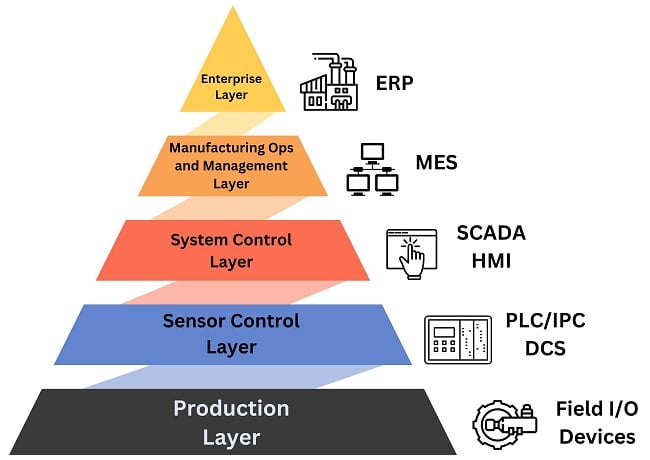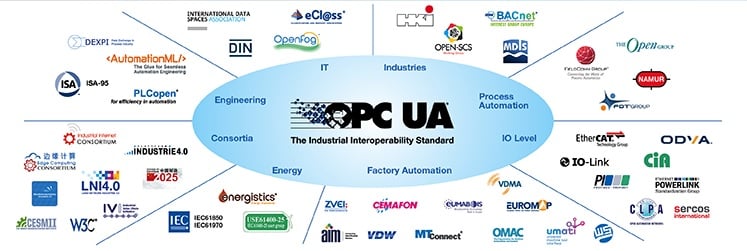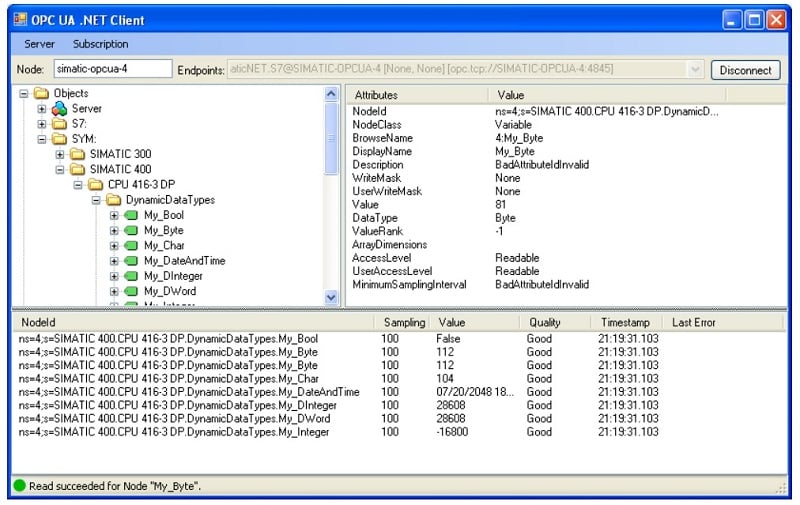The OPC UA protocol is designed to solve two problems in automation: interoperability between device vendors and independence from incompatible transport layer differences.
One of the cornerstones of the Industry 4.0 movement is the availability and efficient flow of data.
Modern manufacturing facilities increasingly rely on high levels of horizontal and vertical integration across systems and between machines. Horizontal integration refers to the interconnections between processes and machines at the same hierarchical level, enabling entire factories to communicate in near real time. Vertical integration, as defined by the ISA-95 automation pyramid, is the transfer of data between several business layers. It covers the interoperability of floor level equipment, PLCs, SCADA systems, operations management tools, and enterprise resource planning software.

Figure 1. The ISA-95 pyramid of automation
The efficient flow of communication across platforms, both horizontally and vertically, has never been more essential. This type of communication is most commonly referred to as Machine-to-Machine or M2M. Although the name implies physical machines, the concept of M2M also applies to the interfacing between machines and software applications, and even between two or more software-only platforms.
Modern automated processes often comprise a wide range of machine types, software applications, and a network of vendors and OEMs. The architectural design of such a process can quickly grow in complexity. To tackle the challenge of seamless flow of data in such an environment requires a robust and flexible solution. Enter OPC UA.
What is OPC UA?
Open Platform Communications Unified Architecture is referred to as OPC UA. The implementation of this industrial communications protocol is increasing in both scale and complexity. We provided a basic overview of the OPC UA protocol in a previous article, describing its key characteristics and functions. This article dives deeper into M2M integration and examines how OPC UA’s capabilities satisfy industrial objectives.

Figure 2. International standards supported by OPC UA.
Achieving Interoperability with OPC UA
Machine-to-machine communication enables complex automated interactions between the various systems and machines that comprise an ecosystem. One of the main challenges to achieving true M2M integration today is the diversity of devices, software platforms, and protocols deployed within the ecosystem. Many communication protocols tend to be proprietary, which can cause unintentional data silos and further complicate things.
To address this, OPC UA leverages the Unified Data Model (UDM), one of its most powerful features. This model enables interoperability by providing a common framework for the representation and transfer of data across multiple platforms.
What is a Node in OPC UA?
As specified by the UDM, in OPC UA, everything from a simple sensor to an abstract software relationship is represented as a node. Each node is described by its attributes and its references. Some of the most common node attributes include:
- NodeId: unique identifier.
- DisplayName: a readable name for facilitate browsing.
- DataType: boolean, integer, string, etc.
- Value: the current data or status held by the node.

Figure 3. An example OPC UA setup screen showing options for attributes and references, this example linking to a Siemens PLC.
While the attributes help describe a node, the references help determine their relationships to other nodes within the system. Nodes can be interconnected in ways that can provide hierarchy and structure. Some common references are:
- HasSubType: establishes vertical hierarchies between nodes.
- HasCause and HasEffect: establishes a cause-and-effect relationship. This is very helpful for fault troubleshooting.
- HasInterface: helps implement standard communication interfaces, such as TCP/IP.
- HasProperty: links nodes with property nodes.
OPC UA supports all well-known data types, including integers, strings, arrays, and complex structures. Custom data types are also supported, allowing the representation of abstract composite structures.
Another key concept pertaining to interoperability is the Address Space. While the Unified Data Model deals with the standard representation of data, the Address Space is concerned with its structure and organization. Using an OPC UA-enabled application such as Kepware, the Address Space gives the user a system layout explaining how everything is connected.
Transport Layer Independence
Transport layer independence makes OPC UA highly compatible. You might also call this feature “protocol-agnostic”. It is another reason why OPC UA has stood out and become so popular. Essentially, transport layer independence separates the transport layer from protocol-specific semantics, allowing different protocols to use data without making any changes to it.
Some communication protocols supported by OPC UA include TCP/IP, HTTP and HTTPS, MQTT (very common in IoT applications), and many factory-floor Ethernet-based protocols.
The power of this feature cannot be overstated. Many state-of-the-art systems comprise multiple communication protocols, forming a complex and heterogeneous industrial network landscape. OPC UA addresses this challenge by providing a unified system thanks to transport layer independence.
Using OPC UA to Integrate Legacy Systems
One important advantage worth mentioning is the integration between modern and legacy systems enabled by this feature. OPC UA can help establish interfaces between devices using old communication protocols and new IoT devices coexisting within the same ecosystem. In addition, the protocol-agnostic nature of OPC UA makes it future-proof, since it can incorporate future protocols by design.
In this article, we have learned how OPC UA addresses two important challenges in modern manufacturing environments. OPC UA fosters interoperability, enhancing operational efficiency, ensuring future scalability, and helping eliminate data silos.
Copyright Statement: The content of this website is intended for personal learning purposes only. If it infringes upon your copyright, please contact us for removal. Email: admin@eleok.com
